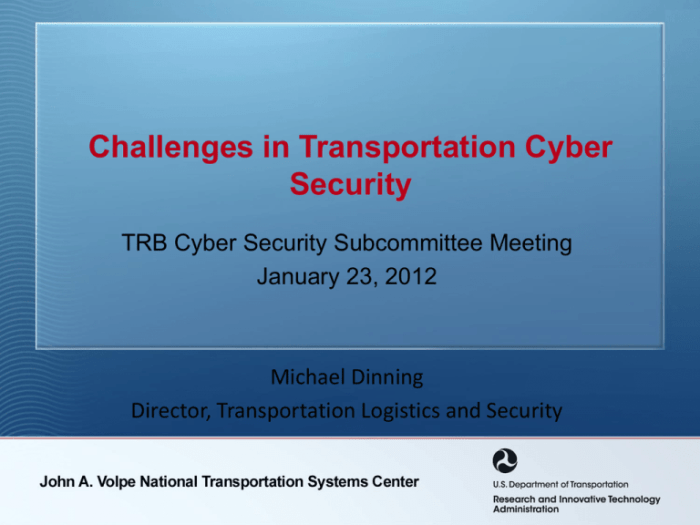Sylvia commutes to work via public transportation cyber awareness is a topic of paramount importance in today’s digitally connected world. As individuals increasingly rely on public transportation systems, they become more vulnerable to a range of cyber threats. This article delves into the specific cyber risks faced by commuters and provides practical guidance on how to stay safe while using public transportation.
Commuters using public transportation face a unique set of cyber threats. These threats include phishing attacks, malware infections, and identity theft. Phishing attacks attempt to trick individuals into revealing sensitive information, such as passwords or credit card numbers, by sending emails or text messages that appear to come from legitimate sources.
Malware is software that can be downloaded onto a device without the user’s knowledge and can steal personal information or damage the device. Identity theft occurs when someone uses another person’s personal information to commit fraud or other crimes.
Public Transportation Security

Public transportation is a common mode of commuting for many people, but it also presents unique cybersecurity risks. Commuters using public transportation may face phishing attacks, malware, and identity theft. Phishing attacks attempt to trick users into revealing sensitive information, such as passwords or credit card numbers, by posing as legitimate organizations.
Malware is software that can damage or steal data from a device, and identity theft occurs when someone uses another person’s personal information to commit fraud.To stay safe from these threats, commuters should be aware of the risks and take steps to protect themselves.
They should never click on links or open attachments in emails from unknown senders, and they should only download apps from trusted sources. They should also use strong passwords and enable two-factor authentication whenever possible.Situational awareness is also important for preventing cybercrimes.
Commuters should be aware of their surroundings and be wary of people who are trying to distract them or gain access to their devices. They should also be careful about what they share on social media, as this information can be used to target them with phishing attacks or other scams.
Cybersecurity Education for Commuters

Public transportation commuters are a target audience for cybersecurity awareness campaigns because they are often exposed to the risks associated with using public transportation. They may be using their devices to access sensitive information, such as banking or work documents, and they may be using public Wi-Fi networks, which can be insecure.To
effectively reach this audience, cybersecurity awareness campaigns should use clear and concise messaging that is easy to understand. They should also use a variety of communication channels, such as social media, posters, and handouts.Educational materials, such as infographics and videos, can be used to promote cyber hygiene practices.
These materials should be visually appealing and easy to understand, and they should provide practical tips that commuters can use to protect themselves from cyber threats.
Technology and Security

Mobile devices and wireless networks are commonly used on public transportation. However, these technologies can also pose cybersecurity risks.Mobile devices are often used to access sensitive information, such as banking or work documents. They can also be used to track users’ locations and activities.
Wireless networks can be insecure, allowing attackers to intercept data that is transmitted over the network.To use mobile devices securely while commuting, commuters should use strong passwords and enable two-factor authentication. They should also be careful about what they share on public Wi-Fi networks.
They should only access sensitive information over secure networks, and they should avoid using public Wi-Fi networks for banking or other sensitive activities.
Collaboration and Partnerships: Sylvia Commutes To Work Via Public Transportation Cyber Awareness

Collaboration and partnerships are essential for implementing effective cybersecurity awareness initiatives. Transportation authorities, law enforcement, and community organizations can all play a role in educating commuters about cybersecurity risks and promoting cyber hygiene practices.Transportation authorities can provide funding for cybersecurity awareness campaigns and can distribute educational materials to commuters.
Law enforcement can investigate and prosecute cybercrimes, and they can provide training to commuters on how to stay safe from cyber threats. Community organizations can provide outreach to underserved communities and can help to promote cybersecurity awareness in a variety of ways.By
working together, these organizations can create a more secure environment for public transportation commuters.
Essential Questionnaire
What are the most common cyber threats faced by commuters using public transportation?
The most common cyber threats faced by commuters using public transportation include phishing attacks, malware infections, and identity theft.
How can commuters protect themselves from phishing attacks?
Commuters can protect themselves from phishing attacks by being cautious about the emails and text messages they receive. They should never click on links or open attachments from unknown senders. They should also be wary of emails or text messages that appear to come from legitimate sources but contain misspellings or grammatical errors.
What should commuters do if they think they have been the victim of a cybercrime?
If commuters think they have been the victim of a cybercrime, they should report it to the authorities and contact their financial institution to freeze their accounts.